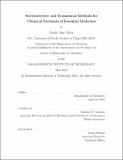Stereoselective and Economical Methods for Chemical Synthesis of Essential Medicines
Author(s)
Mear, Sarah Jane
DownloadThesis PDF (16.82Mb)
Advisor
Jamison, Timothy F.
Terms of use
Metadata
Show full item recordAbstract
Executive Summary: Innovation in synthetic chemistry enables pharmaceutical research and development by allowing the exploration of diverse chemical space during drug discovery, and by encouraging the development of economical and sustainable solutions in active pharmaceutical ingredient (API) manufacturing. For a given API, a single stereoisomer often displays preferable chemical and pharmacological properties including potency, stability, solubility, or toxicity. Methods for diastereo- or enantioselective synthesis are highly desirable, for exploration of biological properties of different stereoisomers, or for driving efficiency during drug manufacturing. In this thesis, synthesis of small molecule drugs emtricitabine, lamivudine, bedaquiline, and diazepam was investigated. Stereoselective strategies and cost-of-goods reduction more broadly are described. Lastly, a perspective on reproductive health safety in the chemical laboratory is presented.
Chapter 1: Diazotization of S-Sulfonyl-Cysteines. We report the synthesis of enantiomerically enriched 𝛽-thio-𝛼-hydroxy and 𝛼-chloro carboxylic acid and ester building blocks by diazotization of S-sulfonyl-cysteines. Within these pharmaceuticallyrelevant building blocks, the thiosulfonate protecting group demonstrated resistance to oxidation and attenuation of sulfur’s nucleophilicity. The key transformation was optimized by a 2² factorial design of experiment, highlighting the unique reactivity of cysteine derivatives in comparison with aliphatic amino acids.
Chapter 2: Synthesis of Emtricitabine and Lamivudine by Chlorotrimethylsilane- -Sodium Iodide-Promoted Vorbrüggen Glycosylation. By simply adding water and sodium iodide (NaI) to chlorotrimethylsilane (TMSCl), promotion of a Vorbrüggen glycosylation en route to essential HIV drugs emtricitabine (FTC) and lamivudine (3TC) is achieved. TMSCl–NaI in wet solvent (0.1 M water) activates a 1,3-oxathiolanyl acetate donor for N -glycosylation of silylated cytosine derivatives, leading to cis oxathiolane products with up to 95% yield and >20:1 d.r.. This telescoped sequence is followed by recrystallization and borohydride reduction, resulting in rapid synthesis of (±)-FTC/3TC from a tartrate diester.
Chapter 3: Diastereoselectivity is in the Details: Minor Changes Yield Major Improvements to the Synthesis of Bedaquiline. Bedaquiline is a crucial drug in the global fight against tuberculosis, yet its high price places it out of reach for many patients. Herein, we describe improvements to the key industrial lithiation-addition sequence that enable a higher yielding and therefore more economical synthesis of bedaquiline. A focus on reproducibility and mechanistic understanding led to optimized conditions that double the previously reported yields of racemic bedaquiline simply by changing the lithium amide base and including a salt additive. We anticipate facile implementation of these improvements on manufacturing scale that will increase throughput of this essential medication.
Chapter 4: Synthesis of a Key Precursor to Benzodiazepines by Copper Hydride Reduction of 2,1-benzo[c]isoxazole. Benzodiazepines are used broadly for the treatment of anxiety disorders and for general anaesthesia. Herein we describe a new method for synthesis of diazepam precursor 2-amino-5-chlorobenzophenone by N,Oreduction of 5-chloro-3-phenylbenzo[c]isoxazole using copper hydride. The desired compound is prepared in >80% isolated yield by optimizing reaction parameters to prevent overreduction of the product. We outline future directions including continuous flow processing and purification by recrystallization.
Chapter 5: A Call for Increased Focus on Reproductive Health within Lab Safety Culture. The approach to reproductive health and safety in academic laboratories requires increased focus and a shift in paradigm. Our analysis of the current guidance from more than 100 academic institutions’ Chemical Hygiene Plans (CHPs) indicates that the burden to implement laboratory reproductive health and safety practices is often placed on those already pregnant or planning conception. We also found inconsistencies in the classification of potential reproductive toxins by resources generally considered to be authoritative, adding further confusion. In the interest of human health and safe laboratory practice, we suggest straightforward changes that institutions and individual laboratories can make to address these present deficiencies: Provide consistent and clear information to laboratory researchers about reproductive health and normalize the discussion of reproductive health among all researchers. Doing so will promote safer and more inclusive laboratory environments.
Date issued
2022-05Department
Massachusetts Institute of Technology. Department of ChemistryPublisher
Massachusetts Institute of Technology